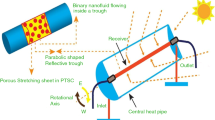Abstract
This paper presents a novel design of micro solar sails for emerging lightweight chip scale spacecraft based on flexible electronic circuits. To acquire large deformation, the micro solar sails were designed to be bilayer beams that were able to be electro-thermally actuated by Joule heating. The concept design of the solar sail with high area-to-mass ratios allowed the solar sailing system, named as ChipSail, for efficient orbital transfer and attitude adjustment. The principle of solar sailing with ChipSail was illustrated, and the thickness of the two metals for the bilayer sails should be no more than 1 µm, so as to achieve the efficient solar sailing. Then, the fabrication and characterization of such bilayer microstructures for solar sails were introduced briefly. After that, the electro-thermal analysis of such solar sails deployed on the low earth orbit was carried out, and it was found that the balanced temperature of the sails under the effect of solar radiation and thermal reemission of the sails was 315.31 K, followed by electro-thermal modelling of the sails under the Joule heating. A nonlinear second order differential equation was derived, which allowed rapid prediction of the thermal distribution across the sail. Equivalence of the bilayer solar sail to a width-changing 980 µm long bilayer beam was proposed and validated by finite element analysis. Finally, the thermo-mechanical model on the bilayer sail was then established and solved numerically. Results showed that the maximum bending angle could reach to 94.05º by applying a voltage of 0.05 V across the sail. The electro-thermo-mechanical model laid a solid foundation for dynamic control of the configuration of the ChipSail for efficient orbital transfer and attitude adjustment in space.









Similar content being viewed by others
References
Acome E et al (2018) Hydraulically amplified self-healing electrostatic actuators with muscle-like performance. Science 359:61–65
Barnhart DJ, Vladimirova T, Sweeting MN (2007) Very-small-satellite design for distributed space missions. J Spacecr Rockets 44:1294–1306
Boni L, Quarta AA, Mengali G (2019) Thermal-structural analysis of a square solar sail. Acta Astronaut 154:268–277
Chen T, Bilal OR, Shea K, Daraio C (2018) Harnessing bistability for directional propulsion of soft, untethered robots. Proc Natl Acad Sci U S A 115:5698–5702. https://doi.org/10.1073/pnas.1800386115
Chirarattananon P, Ma KY, Wood RJ (2014) Adaptive control of a millimeter-scale flapping-wing robot. Bioinspir Biomim 9:025004. https://doi.org/10.1088/1748-3182/9/2/025004
Galos R, Shi Y, Ren Z, Zhou L, Sun H, Su X, Yuan J (2017) Electrical impedance measurements of PZT nanofiber sensors. J Nanomater 2017:8275139. https://doi.org/10.1155/2017/8275139
Galos R et al (2018) The dielectric constant of PZT nanofiber at visible and NIR wavelengths. Nanostr Nanoobjects 15:205–211. https://doi.org/10.1016/j.nanoso.2017.10.001
Hein AM, Burkhardt Z, Eubanks TM (2019) AttoSats: ChipSats, other Gram-Scale Spacecraft, and Beyond arXiv preprint arXiv:191012559
Hines L, Petersen K, Lum GZ, Sitti M (2017) Soft actuators for small-scale robotics. Adv Mater 29:1603483
Investigators PPST (2009) The penumbra pivotal stroke trial: safety and effectiveness of a new generation of mechanical devices for clot removal in intracranial large vessel occlusive disease. Stroke 40:2761–2768
Johnson L, Whorton M, Heaton A, Pinson R, Laue G, Adams C (2011) NanoSail-D: a solar sail demonstration mission. Acta Astronaut 68:571–575. https://doi.org/10.1016/j.actaastro.2010.02.008
Khan S, Lorenzelli L, Dahiya RS (2014) Technologies for printing sensors and electronics over large flexible substrates: a review. IEEE Sens J 15:3164–3185
Macdonald M, McInnes C (2011) Solar sail science mission applications and advancement. Adv Space Res 48:1702–1716
Manchester Z, Peck M, Filo A (2013) KickSat: a crowd-funded mission to demonstrate the world’s smallest spacecraft. In: 27th AIAA/USU Conference on Small Satellites. Logan, UT
Nathan A et al (2012) Flexible electronics: the next ubiquitous platform. Proc IEEE 100:1486–1517. https://doi.org/10.1109/jproc.2012.2190168
Ogando K, La Forgia N, Zarate J, Pastoriza H (2012) Design and characterization of a fully compliant out-of-plane thermal actuator. Sens Actuators A 183:95–100
Panda P, Sahoo B (2015) PZT to lead free piezo ceramics: a review. Ferroelectrics 474:128–143
Reichhardt T (2005) Space technology: setting sail for history. Nature 433:678–680
Ren Z (2020) Design, fabrication and control of reconfigurable active microstructures for solar sails. Stevens Institute of Technology
Ren Z, Yuan J, Su X, Sun H, Galos R, Shi Y (2018) A new fabrication process for microstructures with high area-to-mass ratios by stiffness enhancement. In: International Design Engineering Technical Conferences and Computers and Information in Engineering Conference. American Society of Mechanical Engineers, p V004T008A034. https://doi.org/10.1115/DETC2018-86282
Ren Z et al (2019) Vertical deployment of multilayered metallic microstructures with high area-to-mass ratios by thermal actuation. J Micro Nano Manuf 7:031002. https://doi.org/10.1115/1.4043987
Ren Z et al (2020a) Current divisions and distributed Joule heating of two-dimensional grid microstructures. Microsyst Technol. https://doi.org/10.1007/s00542-020-05103-1
Ren Z et al (2020b) Thermo-mechanical modeling and experimental validation for multilayered metallic microstructures. Microsyst Technol. https://doi.org/10.1007/s00542-020-04988-2
Ren Z et al (2020c) Electro-thermal modeling and experimental validation for multilayered metallic microstructures. Microsyst Technol. https://doi.org/10.1007/s00542-020-04964-w
Ren Z, Yuan J, Su X, Shi Y (2020d) A novel design and thermal analysis of micro solar sails for solar sailing with chip scale spacecraft. Microsyst Technol. https://doi.org/10.1007/s00542-020-05094-z
Ren Z et al (2020e) Multilayered microstructures with shape memory effects for vertical deployment. Microsyst Technol. https://doi.org/10.1007/s00542-020-05101-3
Ridenoure RW et al (2016) Testing the lightsail program: advancing solar sailing technology using a cubesat platform. J Small Satell 5:531–550
Stohlman OR (2018) Coupled radiative thermal and nonlinear stress analysis for thermal deformation in large space structures. In: 2018 AIAA Spacecraft Structures Conference. p: 0448
Su X, Ren Z, Sun H, Shi Y, Pan Q (2018) The submicron fabrication process for T gate with a flat head. In: International Design Engineering Technical Conferences and Computers and Information in Engineering Conference. American Society of Mechanical Engineers, p V004T008A018. https://doi.org/10.1115/DETC2018-85581
Su X, Ren Z, Yan J, Shi Y, Pan Q (2019) Microstructure and twisting ability of an adjusted antisymmetric angle ply laminate. Appl Phys Lett 114:211902. https://doi.org/10.1063/1.5089809
Sun H, Luo J, Ren Z, Lu M, Nykypanchuk D, Mangla S, Shi Y (2020a) Shape memory alloy bimorph microactuators by lift-off process. J Micro Nano Manuf 8:031003. https://doi.org/10.1115/1.4048146
Sun H, Luo J, Ren Z, Lu M, Shi Y (2020b) Effects of deposition and annealing conditions on the crystallization of NiTi thin films by e-beam evaporation. Micro Nano Lett 15:670–673. https://doi.org/10.1049/mnl.2020.0004
Tanaka M (2007) An industrial and applied review of new MEMS devices features. Microelectr Eng 84:1341–1344
Tsai CH, Tsai CW, Chang HT, Liu SH, Tsai JC (2015) Electrothermally-actuated micromirrors with bimorph actuators–bending-type and torsion-type. Sensors (Basel) 15:14745–14756. https://doi.org/10.3390/s150614745
Tsuda Y et al (2011) Flight status of IKAROS deep space solar sail demonstrator. Acta Astronaut 69:833–840. https://doi.org/10.1016/j.actaastro.2011.06.005
Wu L, Xie H (2008) A large vertical displacement electrothermal bimorph microactuator with very small lateral shift. Sens Actuators A 145:371–379
Zhang W-M, Yan H, Peng Z-K, Meng G (2014) Electrostatic pull-in instability in MEMS/NEMS: a review. Sens Actuators A 214:187–218
Zhang J, Wu N, Tong A, Liu Y (2020) Thermally induced dynamic response of a stripped solar sail in low earth orbit. J Spacecr Rockets 57:621–627
Acknowledgements
The National Natural Science Foundation of China (No.11572248) and China Scholarship Council have in part supported the research. The research was in part carried out at the Center for Functional Nanomaterials (CFN), Brookhaven National Laboratory (BNL), which is supported by the U.S. Department of Energy, Office of Basic Energy Sciences, under Contract No. DE-SC0012704. The authors would like to thank Dr. Ming Lu, Dr. Chang-Yong Nam, Dr. Fernando Camino, Dr. Tong Xiao, Dr. Samuel A. Tenney, and Ms. Gwen Wright for helping finish the materials characterization and experimental tests in CFN.
Author information
Authors and Affiliations
Corresponding authors
Additional information
Publisher's Note
Springer Nature remains neutral with regard to jurisdictional claims in published maps and institutional affiliations.
Rights and permissions
About this article
Cite this article
Ren, Z., Yuan, J. & Shi, Y. Electro-thermo-mechanical modelling of micro solar sails of chip scale spacecraft in space. Microsyst Technol 27, 4209–4215 (2021). https://doi.org/10.1007/s00542-020-05204-x
Received:
Accepted:
Published:
Issue Date:
DOI: https://doi.org/10.1007/s00542-020-05204-x




